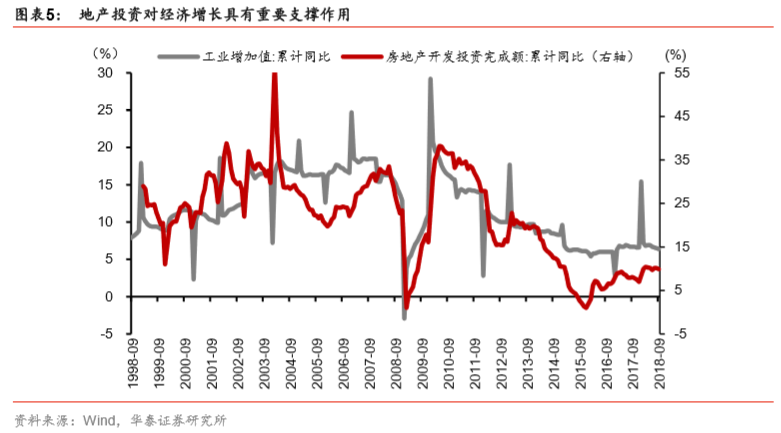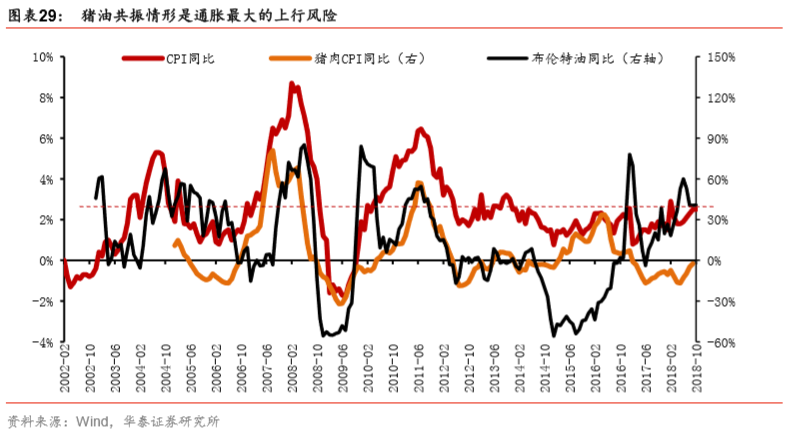Edited by Huatai: "return from Winter and Spring, or not-- 2019 Macro Annual Strategy report"
1. Aggregate economic demand is expected to weaken gradually in 2019.
Huatai expects that there will be some downward pressure on consumption, investment, and import and export growth in 2019. GDP growth in 2019 is expected to continue to drop to about + 6.3% compared with 2018, and infrastructure is still an important tool for steady growth. In the vicinity of mid-2019, if the downward pressure on the economy continues to increase, it is possible to relax the regulation of rigid demand for first-and second-tier real estate.

2. Inflation is expected to rise slightly in 2019, and PPI is lower than in 2018.
Huatai believes that the biggest upside risk to inflation in 2019 is "lard resonance", which is the accelerated spread of the pig epidemic and a higher-than-expected rise in international oil prices driven by geopolitical events. It is expected that the economic stagflation structure will be more prominent in 2019. Nominal GDP growth is expected to continue to decline in 2019 compared with 2018. As an important fundamental factor affecting long-end Treasury interest rates, nominal GDP believes that 10-year Treasury yields still have room for decline.

3. It is believed that unemployment and the balance of payments will be the policy bottom line.
Recently, the employment pressure in China has gradually emerged, it is necessary to pay attention to the risk of breaking 5.5% of the data for individual months in 2019, and the tolerance of the survey unemployment rate is not as high as 5.5%. Upward pressure on unemployment may cause short-term disruption to policy.

Huatai believes that the central bank's attitude towards the goal of balance of payments is more to maintain the bottom line thinking, that is, to maintain policy attention without touching the target bottom line. However, in the context of Sino-US trade friction, it believes that the current account negative phenomenon may continue to occur in 2019, and that the central bank's continued negative growth in foreign exchange share and the continued decline in official foreign exchange reserves will hit the bottom line of the central bank's balance of payments.

4. monetary policy has changed from flexible and moderate to slightly loose.
Huatai believes that the high probability of monetary policy in 2019 will shift from flexible and moderate to slightly loose, and the central bank will still choose quantitative intermediary targets as the main regulation and control targets, with stable growth and employment as the main ultimate goal. M2 and social financial growth are more likely to rebound in 2019.

In order to cope with the downward pressure on the economy, Huatai expects to implement a more proactive fiscal policy in 2019, and it is still possible to increase steadily by reducing taxes and fees, and increasing the fiscal deficit ratio and the new quota of local government special debt in the future.

5. Prospect of asset allocation in 2019
Huatai believes that there may be a similar stagflation pattern in the macro economy in the first half of 2019, and bond allocation needs to be arranged along the fundamentals of downward interest rates, bullish interest rate bonds and participate in infrastructure investment at the same time.

Due to the increasing downward pressure on the economy in 2019, the real estate policy may be adjusted and the suppression of rigid demand will be alleviated. At that time, the real estate industry chain will rise, and we will be optimistic about the opportunities of first and second tier real estate in the second half of the year. At the same time, we believe that the relative returns of the stock market in the second half of the year are better than those in the first half of the year, and the important catalyst is the fourth Plenary session of the 19th CPC Central Committee. Due to the multiple effects of risk preference shock, policy disturbance and overseas events, we need to pay close attention to the negative impact of high volatility in the capital market and be relatively optimistic about gold.

6. Overseas economic recovery has fallen into setbacks
Us economic growth is expected to peak from the fourth quarter of 2018 to the first quarter of 2019, and the Fed faces a dilemma: if the Fed raises interest rates faster than the market expects, there is a risk of a sharp adjustment in US stocks; if the Fed does not raise interest rates, US stocks are likely to continue to hit record highs, making it more difficult for US capital markets to shake off their dependence on monetary policy in special periods.

Huatai believes that the Fed has a high probability of raising interest rates twice in 2019, and stock market fluctuations may reverse the restriction of raising interest rates too quickly. The overall trend of the dollar index is expected to fluctuate downwards in 2019.

7. Hints on the macro risks in 2019: oil price fluctuations, US stock fluctuations and Sino-US game logic may still be deducted.
Huatai believes that the logic of rising oil prices, fluctuations in US stocks and the game between China and the US remain unchanged, and the two major risks may still be a potential threat to economic and market trends in 2019. The main reason for this round of upward oil prices is geopolitical factors in the Middle East. Once geopolitical factors cause a rapid rise in oil prices and push up inflation in China, the central bank will continuously raise interest rates to deal with it, which may lead to the bursting of China's real estate bubble and systemic financial risks.

At present, the valuation of US stocks is still at a high position. Once the US debt rises sharply or the US economy shows signs of peaking, the adjustment of US stocks will still be a drag on the global stock market, and the Chinese stock market is no exception.

Risk Tips:The accelerated spread of the pig epidemic has led to higher-than-expected inflation, and the domestic stagflation environment has caused monetary policy dilemmas; infrastructure growth has not rebounded as scheduled, real estate investment continues to decline, the import and export trade situation is poor, and the domestic economy is declining faster than expected; external risk factors, such as US stock market fluctuations and geopolitical risks, are transmitted to China, increasing downward pressure on the domestic economy and suppressing risk appetite in the domestic capital market.
